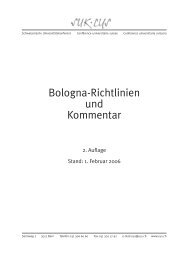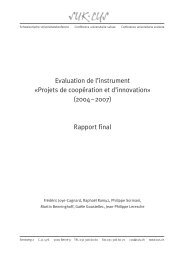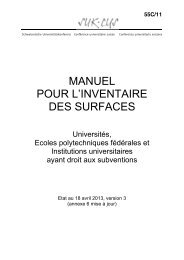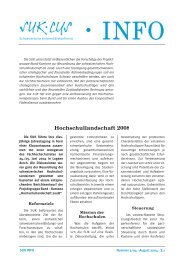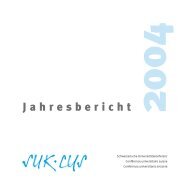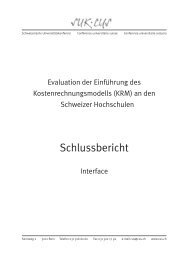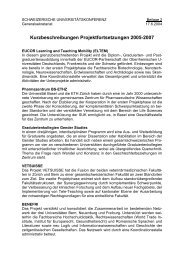Evaluation of the Swiss Virtual Campus - Schweizerische ...
Evaluation of the Swiss Virtual Campus - Schweizerische ...
Evaluation of the Swiss Virtual Campus - Schweizerische ...
You also want an ePaper? Increase the reach of your titles
YUMPU automatically turns print PDFs into web optimized ePapers that Google loves.
SVC Final <strong>Evaluation</strong>. Background Report Lepori and Probst<br />
2 The SVC programme: general outline<br />
The <strong>Swiss</strong> <strong>Virtual</strong> <strong>Campus</strong> (SVC) is <strong>the</strong> federal programme to diffuse <strong>the</strong> use <strong>of</strong> new education<br />
technologies in <strong>Swiss</strong> higher education institutions (HEIs). It lasted nine years (1999-2008) with<br />
a total federal funding <strong>of</strong> about 75 mio. CHF. It has been part <strong>of</strong> <strong>the</strong> so-called university<br />
cooperation projects financed by <strong>the</strong> State Secretariat for Education and Research (SER) under<br />
<strong>the</strong> new University Act and managed by <strong>the</strong> <strong>Swiss</strong> University Conference (SUC). It has been<br />
co-funded by <strong>the</strong> Federal Office for Pr<strong>of</strong>essional Education and Technology (OPET) for <strong>the</strong><br />
participation <strong>of</strong> Universities <strong>of</strong> Applied Sciences (UAS) and by <strong>the</strong> Council <strong>of</strong> <strong>the</strong> Federal<br />
Institutes <strong>of</strong> Technology (FIT) for <strong>the</strong> participation <strong>of</strong> <strong>the</strong> two FIT to <strong>the</strong> programme.<br />
In this section, we briefly present <strong>the</strong> history and development <strong>of</strong> <strong>the</strong> SVC programme from its<br />
creation in 1999; although <strong>the</strong> consolidation phase is <strong>the</strong> object <strong>of</strong> this evaluation, many <strong>of</strong> <strong>the</strong><br />
features <strong>of</strong> <strong>the</strong> programme can be understood only by looking at its whole development.<br />
2.1 History and background<br />
The SVC programme was launched in 1999 by a proposal <strong>of</strong> <strong>the</strong> SUC and <strong>of</strong> its planning<br />
commission to promote <strong>the</strong> use <strong>of</strong> new information and communication technologies in <strong>the</strong><br />
<strong>Swiss</strong> HEI, following a number <strong>of</strong> studies and reports at <strong>the</strong> end <strong>of</strong> <strong>the</strong> 90’s showing that <strong>Swiss</strong><br />
HEI were slow in introducing <strong>the</strong>se instruments in education activities (CUS 1996 and 1997).<br />
Besides this general goal, <strong>the</strong> main initial focus <strong>of</strong> <strong>the</strong> programme was to produce digital<br />
educational units which could be used by students <strong>of</strong> different institutions and recognized in<br />
<strong>the</strong>ir curricula, hence <strong>the</strong> name <strong>of</strong> <strong>Swiss</strong> <strong>Virtual</strong> <strong>Campus</strong> (Conseil fédéral 1998). The overall<br />
policy goals, as stated in <strong>the</strong> Research and Higher Education Message 2000-2003 <strong>of</strong> <strong>the</strong><br />
Federal government, were to promote <strong>the</strong> cooperation between HEIs, to promote innovation in<br />
pedagogical methods and to produce high-quality educational materials. The programme was<br />
part <strong>of</strong> <strong>the</strong> activities managed by <strong>the</strong> SUC under <strong>the</strong> University Act in order to promote<br />
cooperation and modernization <strong>of</strong> <strong>the</strong> <strong>Swiss</strong> higher education system.<br />
The so-called Impulse Programme in <strong>the</strong> years 2000-2003 was essentially focused on <strong>the</strong><br />
realisation <strong>of</strong> projects for <strong>the</strong> development <strong>of</strong> on-line educational modules in specific subjects; in<br />
two calls for proposals, 50 projects were selected, covering almost all educational domains in<br />
<strong>Swiss</strong> higher education institutions. The projects were realised by consortia <strong>of</strong> different<br />
universities from a minimum <strong>of</strong> 3 partners up to a maximum <strong>of</strong> more than 10 partners for some<br />
projects, including higher education institutions, research institutes, support services and private<br />
companies. Projects were built as largely stand-alone teams including all <strong>the</strong> needed<br />
competences for <strong>the</strong>ir realization in <strong>the</strong> specific educational subject, in pedagogy, technology<br />
and design. Accordingly, <strong>the</strong> size <strong>of</strong> <strong>the</strong> projects was ra<strong>the</strong>r large, with an average federal<br />
contribution <strong>of</strong> 600,000 CHF; some projects received more than 1 mio. CHF <strong>of</strong> federal funding<br />
(plus <strong>the</strong> resources invested by <strong>the</strong> involved institutions; see <strong>the</strong> evaluation report <strong>of</strong> <strong>the</strong><br />
impulse phase for detailed data).<br />
Overall, <strong>the</strong> Impulse Programme was financed by <strong>the</strong> Confederation with 30 mio. CHF for <strong>the</strong><br />
universities, 7 mio. CHF for <strong>the</strong> UAS and 2 mio. CHF for <strong>the</strong> FIT; about 34 mio. CHF have been<br />
spent by <strong>the</strong> projects, <strong>the</strong> rest for <strong>the</strong> management <strong>of</strong> <strong>the</strong> programme and for specific support<br />
mandates in organization, pedagogy and technology. To <strong>the</strong>se funds, we should add <strong>the</strong><br />
matching funds for projects invested by <strong>the</strong> institutions <strong>the</strong>mselves (at least <strong>the</strong> same amount<br />
as <strong>the</strong> federal funding).<br />
The evaluation <strong>of</strong> <strong>the</strong> impulse phase showed that <strong>the</strong> programme had been quite successful in<br />
promoting new initiatives for <strong>the</strong> introduction <strong>of</strong> ICT in higher education and had created a<br />
favourable environment for experimenting with e-learning in higher education (Gertsch, Perellon<br />
and Weber 2004); moreover, specific competences were developed and many <strong>of</strong> <strong>the</strong> realised<br />
educational modules were evaluated as being innovative and <strong>of</strong> quite good quality. During this<br />
phase, it became progressively clear that <strong>the</strong> goal <strong>of</strong> developing shared educational modules<br />
fully on-line was not well-adapted to <strong>the</strong> <strong>Swiss</strong> context, and, in practice, most projects shifted to<br />
a blended-mode approach, where <strong>the</strong> use <strong>of</strong> electronic resources was closely integrated with<br />
classroom work and <strong>the</strong>refore adapted by <strong>the</strong> course/teacher. A second concern was raised<br />
about <strong>the</strong> consolidation <strong>of</strong> <strong>the</strong> developed competences after <strong>the</strong> end <strong>of</strong> <strong>the</strong> projects and about<br />
<strong>the</strong>ir technical viability, since many projects were based on tools developed ad hoc (Lepori and<br />
Rezzonico 2003) and <strong>the</strong>re were fears that <strong>the</strong> projects were actually too closely linked to<br />
individual people (with <strong>the</strong> risk <strong>of</strong> abandoning <strong>the</strong>m for example in case <strong>of</strong> retirement <strong>of</strong> <strong>the</strong><br />
16



